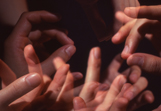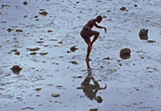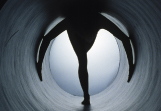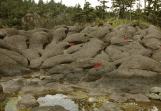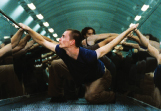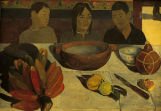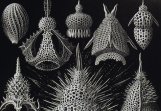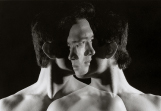 |
 SPECIAL OFFER SPECIAL OFFER
|
 |
 |
 |
 |
|
|
With
the aid of some exquisite dancers and the waters of the Fraser River's
Hells Gate rapids, we re-imagine Chinese Tang and Song dynasty poems,
with their Buddhist layers of reality and illusion, shifting nuances of
human erotic sentiment, and Taoist love of nature. To re-visualize
these layered poems, we reduce the human body to elemental parts:
hands, necks, backs; then we superimpose these parts to construct a
kind of visual polyphony. And we allow one dancer to fly, as in the
Song dynasty cave frescos. (Running time: 6:24)
Choreographer: Wen Wei Wang
Screenings: Zebra (Berlin), Montréal Festival des films du
monde, OxDox (Oxford, UK), VideodanzaBA (Buenos Aires), Agite y sirva,
Sans Souci (U. of Colorado), Dantzaldia Bilbao, InShadow (Lisbon).
Broadcast: ZDF |
 |
 |
|
|
A
little tribe of humans tries to make sense of their dehumanized lives
while passing through Prague. At first, they ride a "pater noster," a
cyclical, continuous elevator in which multiple, door-less cars are
strung along the cables like beads on a rosary. Then they board a
streetcar, cycling in an endless loop through Prague. We are submerged
in our cities, so the cycles of our lives are invisible. This film
offers new ways of looking, using variations on themes of circularity,
the craving for human contact, and a sense of being simultaneously
alone and together. (Running time: 23:50 and 17:39)
Choreographer: Aszure Barton
Screenings: Kolkata Int’l Film Festival, VideodanzaBA (Buenos
Aires), Northwest Film and Video Festival (Judge’s
selection), FICAP (Lisbon). Broadcast: Bravo, ZDF. |
 |
|
|
The
images are lush in the way that Brueghel and Bosch are lush. The theme,
transformation, is expressed by dancers in the roles of chimeras
(mythological creatures made up of parts of different animals, e.g.,
centaurs, minotaurs). The film was shot in the extreme isolation of
Haida Gwaii, where the dancers and crew survival-camped for a month. In
the thick moss, volcanic rock, roots, tide pools, and sheer cliffs, the
extreme demands of the landscape forced the dancers to invent original
ways of moving in each environment. (Running time: 15:58)
Choreographer: Aszure Barton
Screenings: Festival screenings include the Montréal World,
Valladolid Int’l, Vancouver Int’l, New York Dance
on Camera (at Lincoln Center), Zebra Awards (Berlin), Kinotanca
(Poland), Dance Camera Istanbul, Bilbao Int’l, VideodanzaBA
(Buenos Aires), and Dance Camera West (Los Angeles). Broadcasters
include Bravo, the CBC, SCN, ZDF (Germany), and TVE (Spain). |
 |
|
|
7 Universal Solvents
explores the complex theme of human transformation. Dancers dissolve
and recrystallize in a series of visually lush solvents (broadly
defined), an effect created entirely in the camera. The film is shot,
then rewound and re-exposed, creating superimposed image layers -
dancers over solvents. The solvents (physical, social, and
metaphorical) are: water, fire, tigers, children, alcohol, paint, and
air. This last, climactic movement consists of dancers flying through
the air in Limbo. (Running time: 14:44)
Choreographer: Paul-André Fortier
Screenings: Valladolid Int'l, Vancouver Int'l, Toronto Moving Pictures,
Golden Prague (3rd place in Audience "Top Ten"), Madrid. Broadcacast:
Bravo, CBC, TV Espanola & ARTV |
 |
|
|
6 Possibilities
speculates on the origins of life. It grows more complex as it courses
to its climax, imagining the extinction of the human species in a grand
memento mori to lines from Goethe's Der Fischer. It uses very primitive
visual effects: after the initial filming, the exposed film is rewound,
and a second scene is filmed over it, creating layers of images of
dancers, Gaudi's architecture, and the wilderness of Haida Gwaii.
(Running time: 15:04)
Choreographer: Nicole Peisl
Screenings: Montréal Festival des films du monde, Hamburg
Kurzfilm, Québec, Davis, San Francisco Film Arts. Broadcast:
CBC, Bravo, and TV Espanola |
 |
|
|
Filmed in the vast, exquisite subways of Prague, Subways
is based on a poem (Der Panther) by Rilke, about a Panther in a cage in
the Jardin des plantes, Paris. Using Czech and Canadian dancers, the
film conjures up a little world of humans trapped underground,
organizing and reorganizing in response to being trapped. They think
they are free because they can walk from one side of their underground
prison to the other. (Running time: 11:15)
Choreographer: Crystal Pite
Screenings: Montréal Festival des films du monde, Golden
Prague (Dagmar & Vaclav Havel Foundation Prize), Palm Springs
Int'l, Toronto Moving Pictures (NOW Audience Choice Award), Denver
Int'l, San Francisco Film Arts, Valladolid Int'l. Broadcast: CBC, ZDF,
& TV Espanola |
 |
|
|
Every human culture makes art. Something so universal must have a
purpose - what biologists call survival value. Yet our culture has
marginalized art as a luxury and commercialized it as entertainment.
Are we losing something vital for our survival? Using interviews with
some of the leading thinkers of our time, and artwork filmed on
location in the world's great museums, Seducing the Guard asks about the purpose of art and finds deep connections between art and science. (Running time: 54:03)
Screenings:
Int'l Documentary Festival Amsterdam, Golden Prague, Festival of Films
on Art (FIFAP), Paris. Broadcast: Bravo, Knowledge Network, SCN. |
 |
|
|
One
of the deepest, most universal of all human responses is the experience
of beauty. What is it? Beauty is found in painting, music, literature
and dance; but also in natural wilderness, mathematical equations, the
structure of biological organisms, physics, and the cosmos. Accident by Design
looks for common principles. The film intercuts painting, sculpture,
and dance with images from science and nature, and provocative
interview clips. When forms of beauty from very diverse sources are
brought together by montage, the shared principles become visible.
(Running time: 50:39)
Screenings:
the Portland Art Museum Film Series: “Icons, Rebels and
Visionaries.” Purchased by the National Gallery of Art,
Washington, D.C. Broadcast: U.S. Public Broadcasting (PBS Network) by
the American Program Service, WLIW, Bravo, Knowledge Network, and SCN |
 | |
|
By
means of in-camera superimposition, two characters are born from each
of two dancers. The technique works like this: The two dancers are
filmed as they perform; the exposed film is then rewound; and the
dancers are filmed again, on the same piece of film, creating two
superimposed images. The complex emotional relationship between the two
dancers then becomes a duet for four bodies. This is structured as a
visual fugue, using the musical methods of canon, counterpoint,
stretto, etc. The characters are bound by their nature; but their
alter-egos are not so bound, and can detach and observe. (Running time:
8:30)
Screenings:
Seattle Int'l (in Best of Fest Shorts), New York Dance on Camera
(Silver Award), Montréal Festival des films du monde, Odense
Int'l, Denver, Namur, and London Int'l. Broadcast: Bravo &
Knowledge Network. |
 |
Special offer: 3
dance films by Daniel Conrad on a single DVD, including Afternoon of
the Chimeras, 7 Universal Solvents, and Subways: 5 Variations on a
Theme by Rilke.
For personal use only: $40 from Moving Images Distribution (#103
– 511 West 14th Avenue, Vancouver BC, Canada V5Z 1P5 , Canada
• Tel: 604-684-3014 • FAX: 604-684-7165 • www.movingimages.ca) |
|
 |
|
